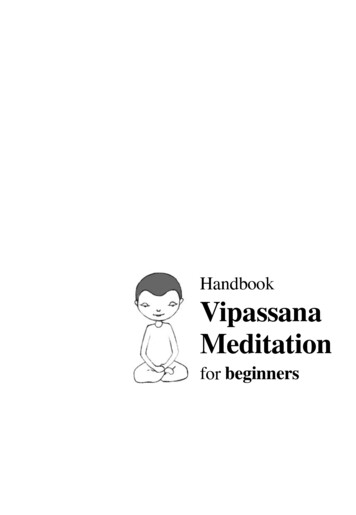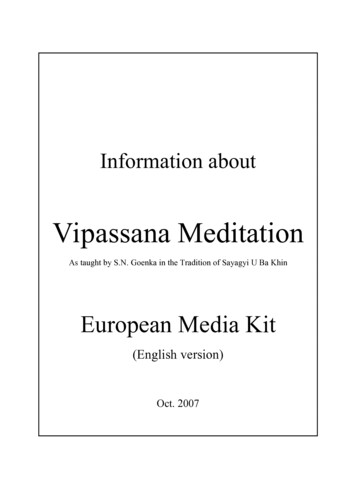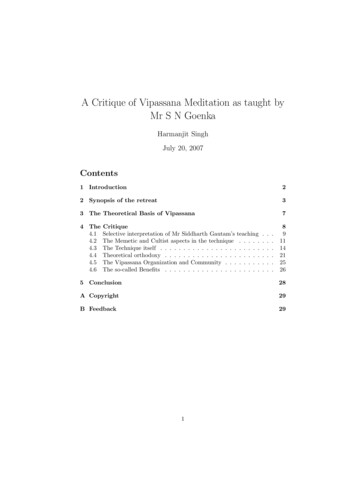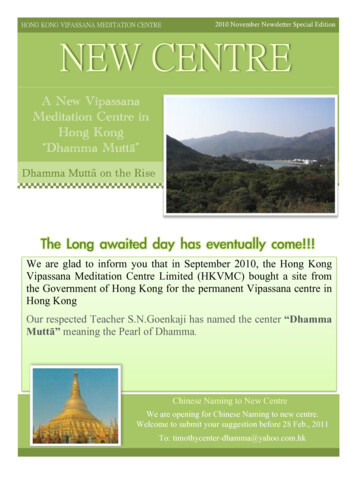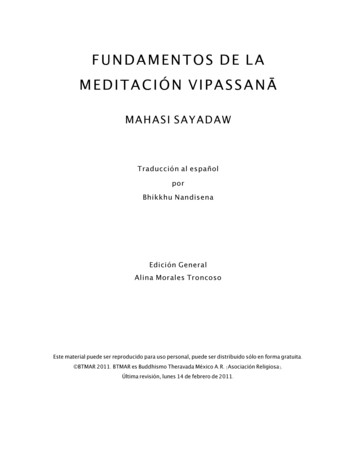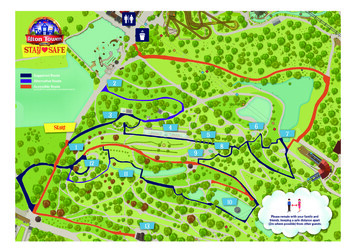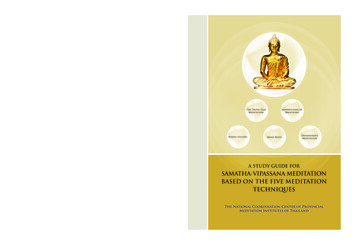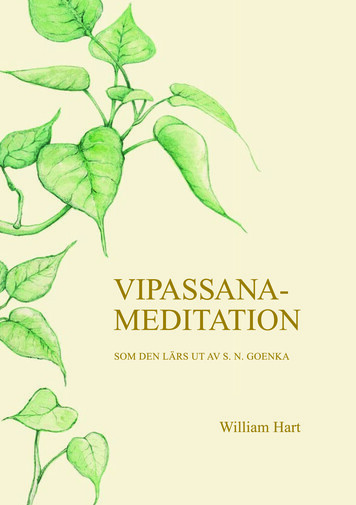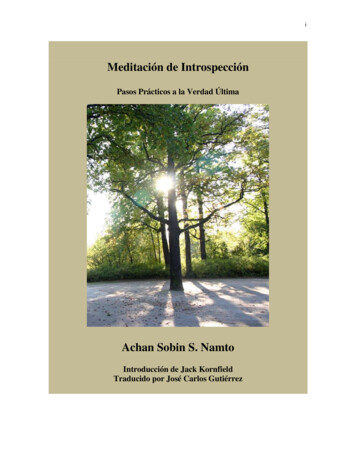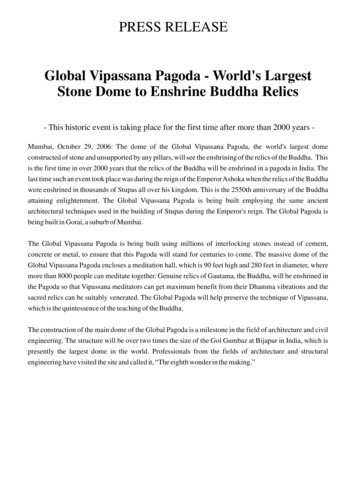
Transcription
PRESS RELEASEGlobal Vipassana Pagoda - World's LargestStone Dome to Enshrine Buddha Relics- This historic event is taking place for the first time after more than 2000 years Mumbai, October 29, 2006: The dome of the Global Vipassana Pagoda, the world's largest domeconstructed of stone and unsupported by any pillars, will see the enshrining of the relics of the Buddha. Thisis the first time in over 2000 years that the relics of the Buddha will be enshrined in a pagoda in India. Thelast time such an event took place was during the reign of the Emperor Ashoka when the relics of the Buddhawere enshrined in thousands of Stupas all over his kingdom. This is the 2550th anniversary of the Buddhaattaining enlightenment. The Global Vipassana Pagoda is being built employing the same ancientarchitectural techniques used in the building of Stupas during the Emperor's reign. The Global Pagoda isbeing built in Gorai, a suburb of Mumbai.The Global Vipassana Pagoda is being built using millions of interlocking stones instead of cement,concrete or metal, to ensure that this Pagoda will stand for centuries to come. The massive dome of theGlobal Vipassana Pagoda encloses a meditation hall, which is 90 feet high and 280 feet in diameter, wheremore than 8000 people can meditate together. Genuine relics of Gautama, the Buddha, will be enshrined inthe Pagoda so that Vipassana meditators can get maximum benefit from their Dhamma vibrations and thesacred relics can be suitably venerated. The Global Pagoda will help preserve the technique of Vipassana,which is the quintessence of the teaching of the Buddha.The construction of the main dome of the Global Pagoda is a milestone in the field of architecture and civilengineering. The structure will be over two times the size of the Gol Gumbaz at Bijapur in India, which ispresently the largest dome in the world. Professionals from the fields of architecture and structuralengineering have visited the site and called it, “The eighth wonder in the making.”
About VipassanaThe technique of Vipassana is a simple, practical way to achieve real peace of mind and tolead a happy, useful life. Vipassana means "to see things as they really are". It is a logicalprocess of mental purification through self-observation.From time to time we all experience agitation, frustration and disharmony. When we sufferwe do not keep our misery limited to ourselves - instead, we keep distributing it to others.Certainly this is not a proper way to live.Vipassana enables us to experience peace and harmony: it purifies the mind, freeing it fromsuffering and the deep-seated causes of suffering. The practice leads step-by-step to thehighest spiritual goal of full liberation from all mental defilements.Vipassana is a scientific non-sectarian meditation technique. People from all religions andcommunities worldwide have participated in Vipassana courses to learn the art of living ahappy and harmonious life.Sacred Relics of the BuddhaAfter the mahaparinibbana (passing away) of the Buddha, 2550 years ago nearKusinara (Kushinagar), Brahman Dona—a wise disciple of the Buddha—divided theBuddha’s bodily remains (Sacred Relics) into eight parts and distributed them among thelocal kings. In accordance with the instructions of the Buddha, the Sacred Relics wereenshrined in magnificent stupas in their capital towns.Emperor Asoka built several stupas all over India. He took out Relics from seven of theoriginal eight stupas and distributed them in these stupas.Some of these Relics were again taken out and enshrined at other places by others. One suchRelic was enshrined in a stupa in Bhattiprolu about 40 km from Guntur in today’s AndhraPradesh. A crystal casket with a Buddha’s Relic was found in the ruins of the great stupa hereby Archaeological Survey of the British Rulers of India. The Viceroy and Governor Generalof India, Lord Chelmsford, gave the Relics to the Maha Bodhi Society of Kolkata in 1920.A part of these Relics was handed over to Acharya S. N. Goenka by Ven. Vipula S ra andVen. Rewata of Maha Bodhi Society in 1997 at the foundation laying ceremony of theGlobal Pagoda. These Relics are now enshrined atop the dome of the Global Pagoda—thelargest dome in the world unsupported by any pillar.29 October, 2006. Buddha Era 2550.
CURRENT CONSTRUCTION STATUSSEPTEMBER 2006This unique pillarless domed structure, 278 feet in diameter and 90 feet high, has been completed and isready for the enshrinement of the Buddha relics. The keystone, which itself weighs four tonnes, is nowin place, marking the occasion of the historic construction of the world's largest stone dome.Combining ancient Indian building traditions with the latest in construction technology, the first 100layers of black basalt and Jodhpur stone are now in place. The stones are held in position by cutting bothhorizontal and vertical grooves, which lock them together even more firmly as more weight is added.In addition, the basement R.C.C. work is complete, as is more than 60,000 sq.ft. of flooring, includingventilations ducts, and the new meditation center adjacent to the Pagoda is partially ready. TheDhamma Hall, Dining Hall, Teacher's Residence and 60 other rooms are expected to be completed byDecember.The outer serration work and work on the second level of the Pagoda is in progress. This will take thePagoda to a height of 325 feet.The small Southern Pagoda foundations are completed, and work is in progress on roads, toilet blocksand staircases. The next phase of the project will include two approach bridges and the Grand Staircase.
Sayagyi U Ba KhinAcharya S.N. GoenkaTo enshrine Holy Relic of Lord Gautama Buddha, the Blessed One, the samewere presented to the Maha Bodhi Sociaty of India, Calcutta by H.E. The Viceroyand Governor General of India Lord Chelmsford, on Friday November 26, 1920Buddha year 2464, A portion of The Sacred Corporeal Relicsof Lord Gautama Buddha that have been enshrinedin The Global Pagoda, discovered fromBhattiprolu Stupa, District Guntur, Andhra Pradesh, India,given by The Maha Bodhi Society of India, Calcutta.
The Sacred Bhattiprolu Stupa, District Guntur, Andhra Pradesh, India.Shri Anagarika Dharmapalajiwas the Founder of The MahaBodhi Society of India,CalcuttaSri Dharmarajika ViharaShrine of The Maha BodhiSociety of India, Calcutta,West BengalTHE MAHA BODHI JOURNAL,APRIL-JUNE 1996 ISSUEKalyanmitra sri S.N. Goenka, eminent meditationteacher who was the Chief Speaker and Guest of Honourin the Vaisakha celebrations paying homage to BuddhaRelics. Ven. Maitipe Wimalasara Thero; Asstt. GeneralSecretary of Maha Bodhi Society of India and Ven. M.Pannaloka Thero, Asstt. Bhikkhu-in-charge, Calcuttaare also in the picture.
Respected AcharyaS.N.Goenkaji is seen herepaying His Respects to TheSacred Corporeal Relics of LordGautama Buddha as mentionedaboveContents of The Sacred RelicCasket No. 3 from Bhattiprolustupa, District Guntur, AndhraPradesh, India. It contained ASacred Bone, other Sacred Relicsand Offerings of Lord GautamaBuddhaContents of The Sacred RelicCasket No. 4 From BhattiproluStupa, District Guntur, AndhraPradesh, India It containedSacred Relics And Offerings ofLord Gautama BuddhaContents of The Sacred RelicCasket No. 5 from BhattiproluStupa, District Guntur, AndhraPradesh, India. It ContainedThree Sacred Bones, One SacredBone was given to Acharya S.N.Goenkaji; another Sacred Bonewas given to a Peace PagodaTemple in Nagoya, Japan; and theThird Sacred Bone was retainedby The Maha Bodhi Society ofIndia, Calcutta
The Casket Containing The Sacred Corporeal Relics OfLord Gautama Buddha Kept in The Shrine Room of SriDharmarajika Vihara, Calcutta.They were discovered from Bhattiprolu stupa, DistrictGuntur, Andhra Pradesh, IndiaBHATTIPROLU : GSRC-III, BS-5 Translation: “This casket is the creation of Kura’s father, and of kura’s mother, and ofkura, and of Siva in order to enshrine Banava’s son’s crystal box (photo-7B) (contains)the Bodily relic of Buddha (This) casket is of Kura, associated with his parents. Thecomposer of the text is Uttara, the Youngest son of Vigraha”.
· 60.SHWEDAGON PAGODA,YANGONCenturies ago Tapussa and Bhallika, two merchants from Ukkala brought the sacred hairs given tothem by Buddha from ( The Middle Districts of) India and enshrined them at the foot of a wood-oiltree Sihguttara Hill where the sacred relics of the former three Buddhas had already beenenshrined. This pagoda is called “The Shrine of the Sacred Relics of Four Buddhas”, because itcontains, enshrined within it, the sacred relics of the three Buddhas (namely, Kakusandba,Konagamana and Kassapa) as well as those of Gautama Buddha. It also takes the name“Shwedagon Pagoda” after the name of the town, Tigumba or Dagon (i.e. Yangon or Rangoon)Successive Mon Kings and Myanmar Kings vied with one another in maintaining and improving theshwedagon which has thus been brought to its present condition and appearance. Shinsawbu,QueenRegnant of Hanthawaddy gave up her throne when she grew old and set up a cantonment and palaceon a pleasant piece of land to the north-west of pagoda and resided there in constant veneration ofthe shrine. She died at the age of 76 in 831 Bur.E. (1470 C.E.) bowing in reverence to the pagoda. Thelocality where Queen lived in her old age is known to this day as Shinsawbu Hill.
Buddha’s sacred relic hair Myanmar Yangon Temples and Palaces Photo Gallery - 05 Buddha’s sacred relic hair picture.The Pagoda has been built to house Buddha relics.
Vipassana enables us to experience peace and harmony: it purifies the mind, freeing it from suffering and the deep-seated causes of suffering. The practice leads step-by-step to the highest spiritual goal of full liberation from all mental defilements. Vipassana is a scientific non-sectarian meditation technique. People from all religions and
